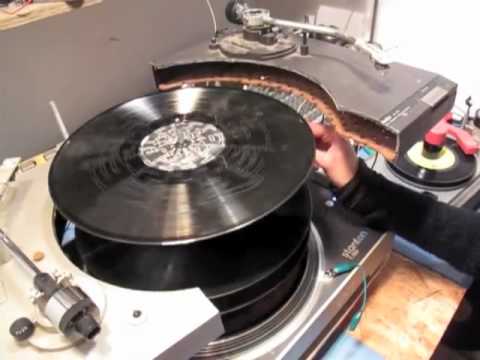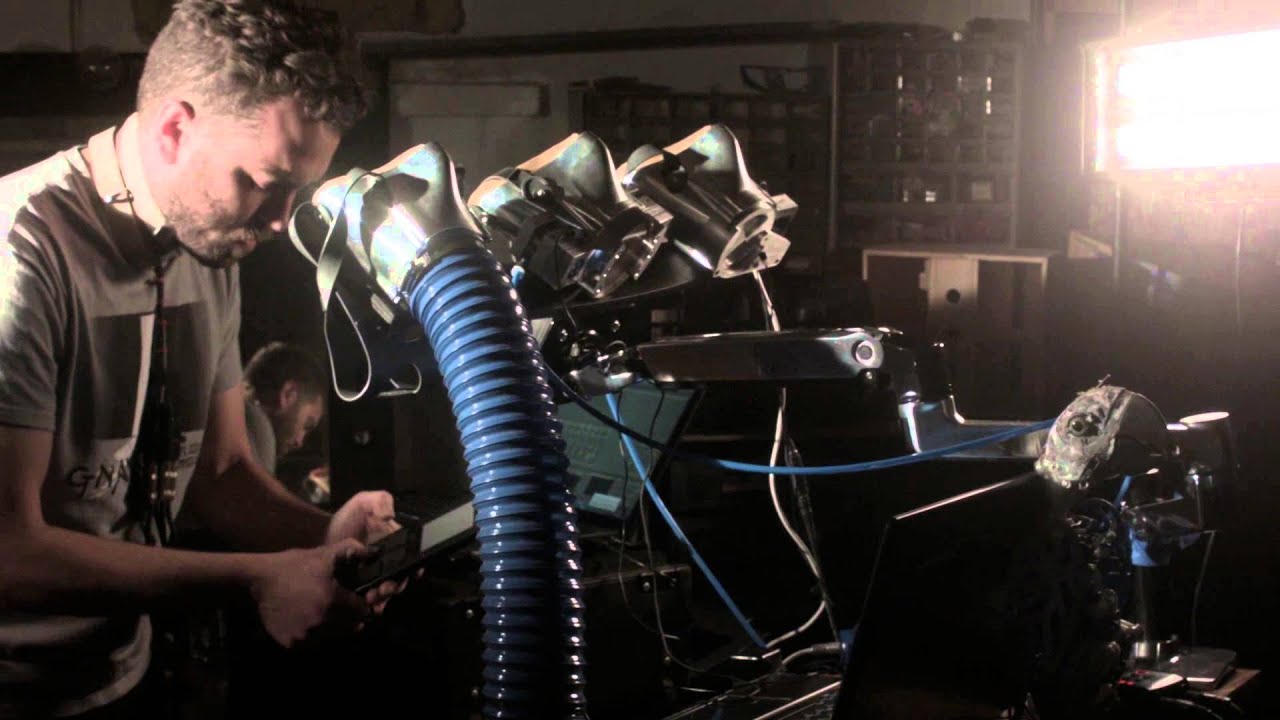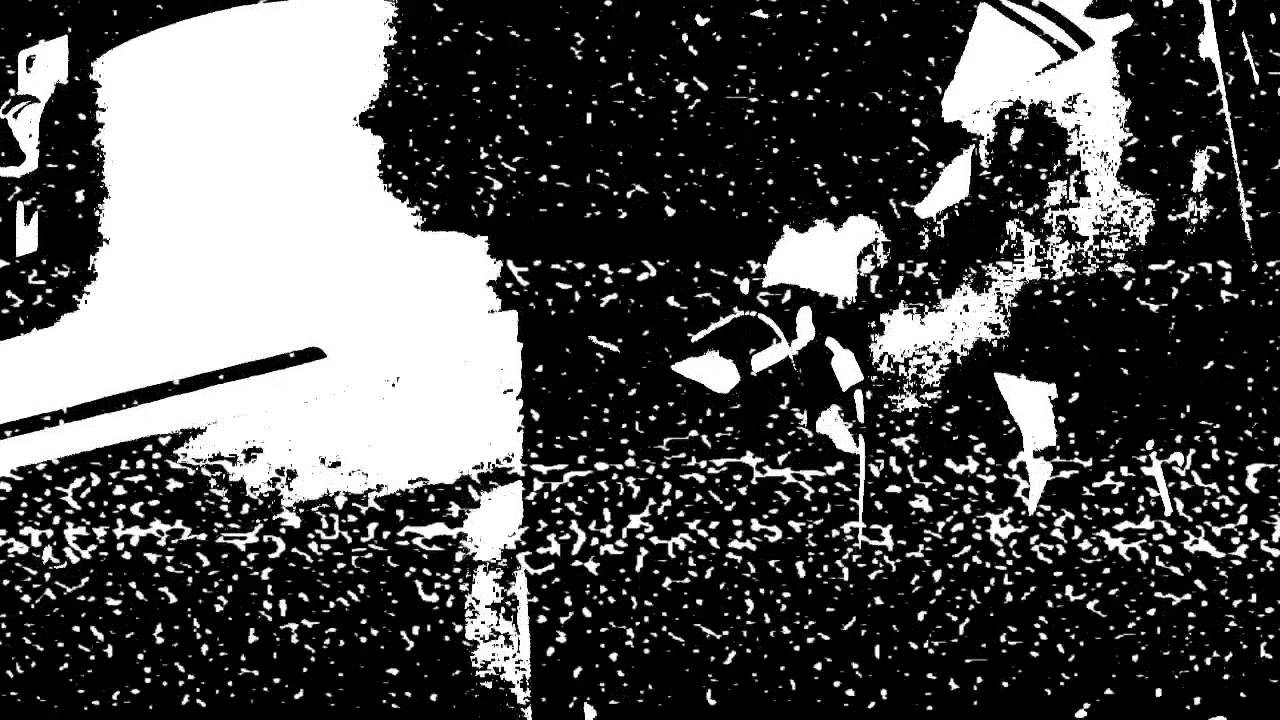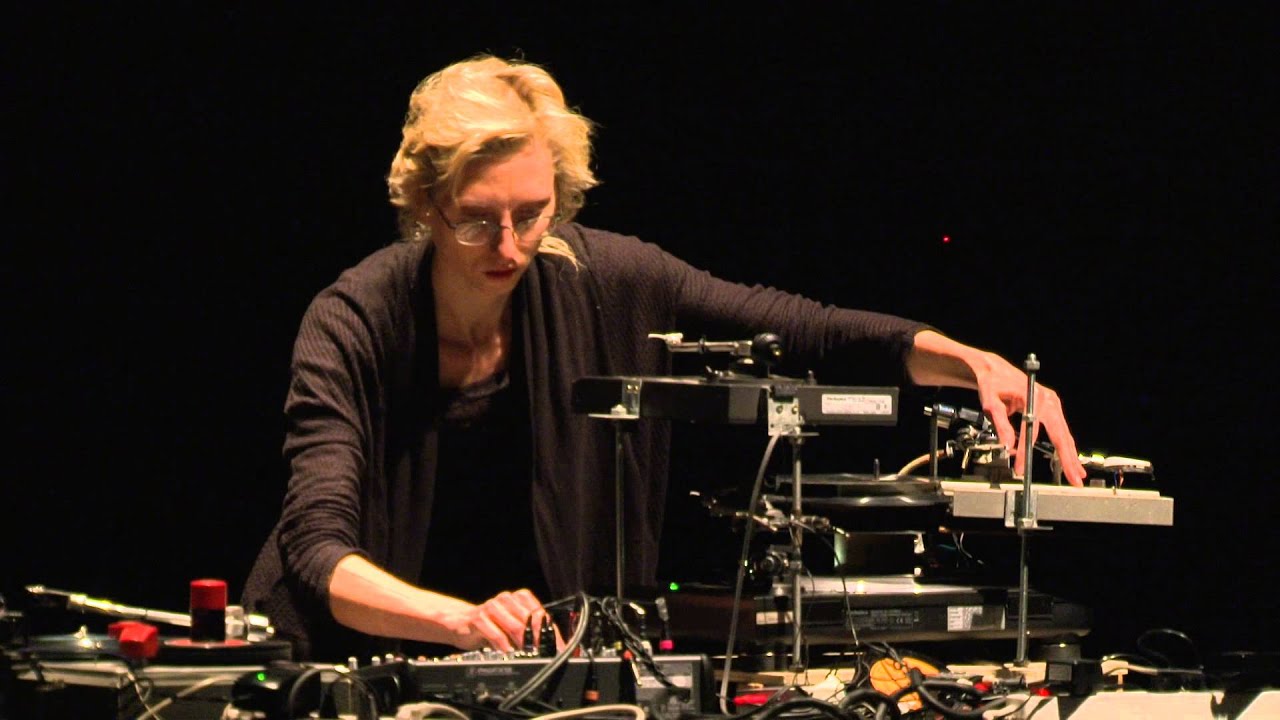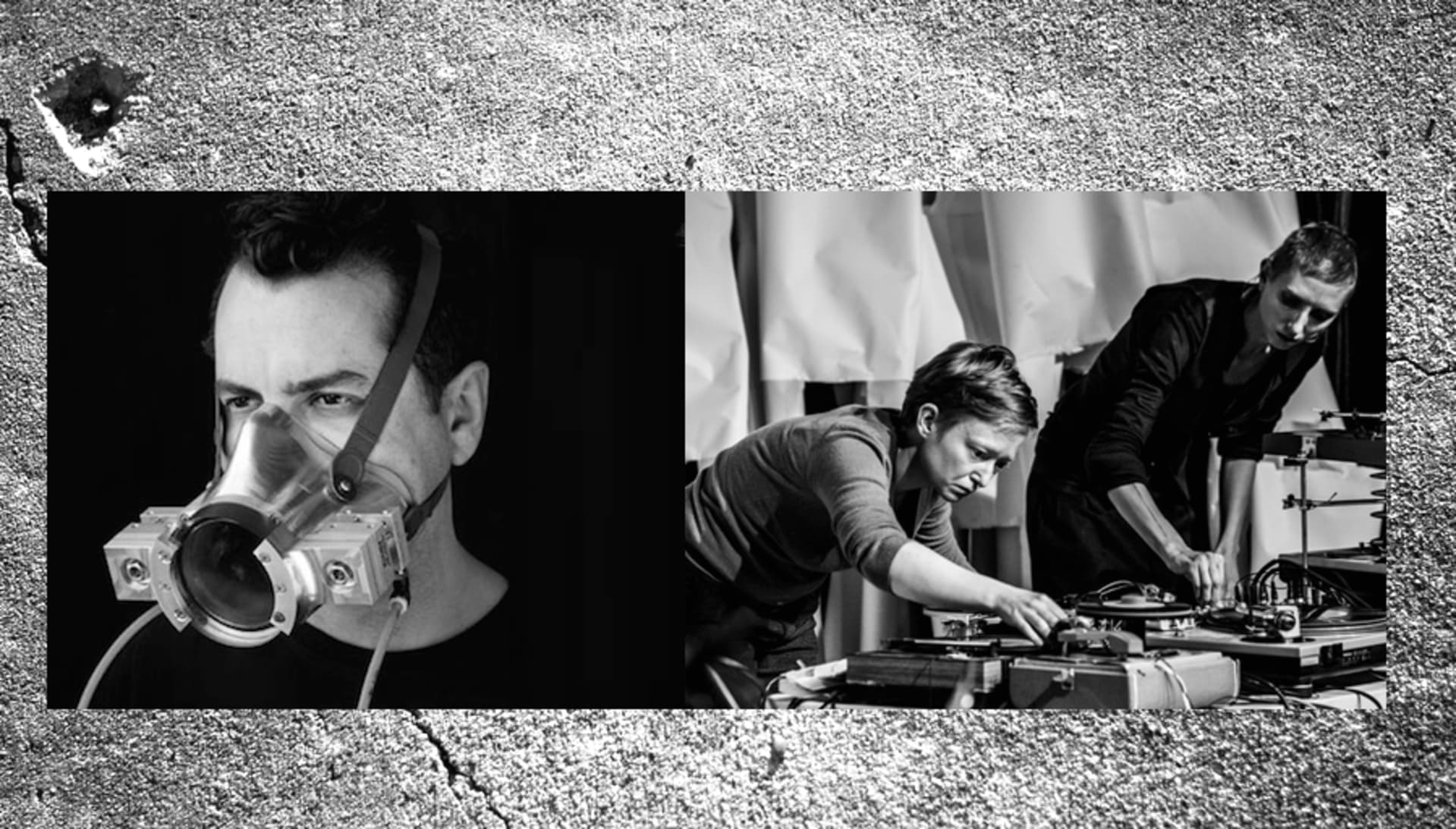
Three Transgressive Artists Turn Destruction into Music
Why try to reinvent the wheel when you can dissect it, shatter the very idea of what a “wheel” is and sock it to the concept of linear musical patterns? That’s exactly what sound artists Vinyl Terror & Horror do. The Berlin-via-Denmark duo of Camilla Sørensen and Greta Christensen reformat the concept of turntablism by intricately destroying then re-deploying record players and assorted vinyl into works of sculptured aural nightmares, cutting records into pieces and filling the gaps with shards of glass, trash or other records to create uneasy symphonies. Fragments of familiar sound pop into existence like ghosts, only to be disrupted by a well-placed piece of metal dropping onto a spinning disc.
As Author & Punisher, Tristan Shone also specializes in the musical construction/destruction business, though his tools aren’t agents of chaos. The San Diego-based engineer creates hand-crafted mechanical controllers and voice manipulators that are finely-honed war tools—massive steel devices that share the same brutal, demon-military aesthetic of his vicious industrial metal. We gathered the forward-thinking sonic weirdos to juxtapose their unique views about the art of crafting sound and supplanting genre.
Camilla Sørensen: Tristan, I was impressed by how technical you are. The equipment you make all looks very advanced compared to us. We’re always struggling to find the right combination of equipment.
Tristan Shone: In my engineering job, I work with many people who make objects and devices that adhere to strict safety regulations. They work in a lab, so the dimensions and designs of objects can be very anal. I respect that, but with my equipment…I know it may look very high-tech, but I’m taking more liberties with safety and construction than I can in my normal job. That’s one of the reasons I like music; I can use all the key design components that I geek out on at work, but I don’t have some manager or safety board telling me that it’s not within spec. That’s the most annoying thing about engineering.
CS: So you get a lot of inspiration from your work?
TS: I love and hate my job, actually. As much as I’d like to get out of it, I wouldn’t be able to do what I do without working with scientists and other industry professionals. I’d much rather be a full-time musician, but in the US that sort of career path is a bit difficult to manage. I really appreciate the freedom you two have and how you work with music. With your experimentations it seems like you had this “Ah-ha!” moment and decided, “We’re going to make record players that do strange things.” It looks like it was a very organic process to get to. It’s very unique. What was the moment that you knew you wanted to make these devices?
Greta Christensen: We started with installations, actually. Playing concerts was kind of birthed from that. We met at the Royal Danish Art Academy in the sculpture department, and we knew early on that we wanted to collaborate and find something connecting objects to sound. We started by buying home organs. We had three that we would play, but we wanted to focus on a different aspect than musicianship or learning to play things “properly.” We wanted to use music as a means to create an atmosphere, and that wasn’t possible with our lack of skill on the organs. So we switched to record players. This was ten years ago or more.
Our first idea was to simply cut up a vinyl record and take the arm away from the player. Since then it’s grown in many ways. We’ve worked with cassette recorders, VHS recorders—all kinds of equipment. But the record player has been there all along, developing into one big organism. The concerts we do are exclusively with record players—no effects or anything. The installations are more complex and involve a lot of different equipment depending on the atmosphere or ideas we want to evoke. But as you observed, it’s been a slow and organic process developing it. It’s taken many years of experience, touching the equipment, learning it and breaking it. A lot of the record players that have gone through our hands didn’t survive. Now we have this gear that we travel with and try not to break, but as you may know, it’s so much fun to build new things that the focus on actually using them is sometimes lacking.
TS: You have to make exceptions to the original purity of the design process just due to the limitations of performance or travel, especially if you don’t have a van. I think some people get caught up in that. I think it’s fun, though. In the US, Guitar Center is basically the only music store that exists in every city. Many times when you want to use a piece of musical equipment, you’re stuck going to this place and using their stands, their cables and so on. It’s nice to see other people breaking out of that and touring with their own setups, their own homemade wires and gear.
CS: What’s funny is that sometimes you can have an idea for something you want to build, and even though you tried your best to build it the way you want it, it turns out completely different. So you surprise yourself.
GC: Everything is guided by limitations and to what is accessible in everyday life. You work in a laboratory, so you’re surrounded by scientists and machines that open up possibilities for you, whereas we have secondhand shops in Berlin where we find things. We work with what’s accessible to everyone and find new ways to use it for our own ends. The size of your studio can really determine the size of what you’re doing. With your stuff, you seem to have a very clear idea of what you’re doing.
TS: To tell you the truth, I can design mechanically and functionally how things move and how they communicate electronically. That stuff is very cut-and-dry for me. When I design something, buy the components and put it together, it’s more or less what I imagined. But the part that’s weird—and this is the same when I’m designing something at work—once you have the mechanical interact with the biological, the electronic with the brain tissue, that’s where things start to get weird. Combining the synthetic with the organic is never cut-and-dry. When I make a machine, I can’t predict the sound component or how I’m going to interact with it, how my body breaks down as I play something. That’s the big surprise. In some ways my instruments have failed me because I didn’t think enough about the final product of what the sound would be. I’ve had to make a few last minute changes.
CS: You mentioned earlier that your devices are all computer controllers. Is the music you make all produced inside the computer?
TS: The sounds are all samples or sine waves. I basically created human-computer interaction devices so that I could control and morph every sound live. It’s not pre-recorded material.
CS: So it’s instruments inside the computer that you control with these devices?
TS: Right. There are very purist analog guys who think that maybe I should have made the insides of the devices make the sounds, so each one contains the electronics that produce the analog signal. It’s a valid point, but I just like being able to change my sounds without having to redesign the innards. What I really wanted to do was find a way to organically control every instrument in real time by myself. So I came up with something I can do with my left hand, something for my right hand, and then something I can do with my voice. Drums are on the right hand; there are eight buttons, and I can keep my right hand moving, triggering all the sounds back and forth. My left hand controls the oscillators. On some of the albums I’ve recorded, I’d go back and fix stuff later, but lately I’ve been recording everything live and getting out of MIDI land.
GC: Surely you cannot carry all these things with you when you travel outside the States to play live. So what do you bring?
TS: Each instrument has its own case, and I’ve welded a bunch of custom stands that are very heavy. Of course, I can’t bring them on a plane, so I bring some things like my microphone, a drum controller and some oscillating synth controllers. I have to get stands wherever I travel, and they look a little weak compared to the custom ones. When you have objects like some of the things I use, you don’t want them to sit on something that doesn’t look like it can hold it. A lot of times people seem a little disappointed that I don’t have large equipment when I play in Europe. “Oh, I thought you’d have that 300-pound thing with you.”
CS: Do you ever do exhibitions with your equipment where they’re presented as objects?
TS: Not anymore. I have, but I’m kind of against it. They really are meant to be played—and by me. I didn’t make them for others to play. Because they’re all computer controllers, for them to have any function they need a computer. I don’t try to make them art. The first projects I had in art school were sort of fabricated: “I’m going to make a sculpture. It’s going to move.” I’d come up with ideas that felt forced. With Author & Punisher, it was very much a set tone, an idea or an emotion that I wanted follow. I keep searching and chasing that very drone-y, rhythmic, industrial tone. Sometimes it’s captured in some of the films I like to watch, or eerie experiences from my childhood that’re awkward to talk about. I’m curious as to what impetus you try to capture yourselves, the atmosphere you mentioned.
GC: It’s different when you’re collaborating. Camilla and I don’t really talk about what we want to do; we each do our own thing with our own setups. If you knew us well, you’d hear the difference, but it’s different and perhaps difficult to be very personal in a collaborative project. With the music and the installations, we always reach for a certain mental state: a place between reality and fiction. As a listener and viewer, we want you to use your imagination.
TS: I’ve found collaboration very difficult, because I think what I’m doing is so personal and I have such specific ideas that I’m not willing to compromise on what the sound and aesthetics should be. Sometimes, when I’ve tried to play with a guitarist or a drummer…it sounds lame, but I feel like everyone in metal wants to make something “heavy.” But there’s a thousand different ideas of what “heavy” means, or “evil,” or “chaos.”
GC: I don’t feel our collaboration makes us compromise. It’s very much the opposite; we compliment each other. Maybe we take different angles, but they meet in the middle. If you dissected one of our installations, we could tell you exactly who did what, but it’s irrelevant to us. What’s important is this atmosphere, this idea of horror where you feel like the worst possible thing could happen in that moment. It’s a special kind of tension that we try to reach with the most minimalistic visual approach. We both agree on it somehow.
CS: Often, the process starts when one of us has an idea of a specific object or picture, and we develop it together, look at it and decide which direction to go next. It’s often when working together that you find an idea has gone a direction you never would have thought of yourself.
TS: Some of us just don’t work very well with other people. But getting back to the idea of “horror” that you mentioned, the idea of the worst possible thing happening…
GC: It all happens in the head; the environment doesn’t always matter. If you have a cup of coffee in your sunny kitchen with the right music, it can be really unsettling. The intention is to take the virginity of innocent objects.
TS: When people use words like “horror,” I sometimes wonder what kind of horror they mean. When I hear your work, I find it very pleasant.
GC: So do I! I also find it very funny. If you look at horror films as a whole, there are recurring elements that just work. Empty rooms. An open door—doors work, because as soon as you have a door there’s the possibility of something behind it. These are subconscious triggers—the familiarity of everyday objects. Every time we make something new, we try to reach a point where we have the biggest emotional effect possible connected to it. The same applies to our concerts. When people work with visual equipment, there’s always the possibility of the excuse, “Well, this sounds bad but at least it looks good.” It’s very important for us that the music leaves the equipment and becomes something by itself. Even if it has the sound of vinyl, it should work well without seeing the equipment. Does that make sense?
TS: Absolutely, I agree with you.
GC: I listened to your releases, and even though it was nice knowing about the process, hearing the music and seeing that it works well without knowing the process is a great quality.
TS: I’d say the same of your music, though I do really like the visual component. The stacking of the records makes me think of an organic sequencer. I love seeing the ways that people get away from MIDI clocks and find new processes. Sometimes I’ll sequence some tracks live, and it always sucks. That means that some of my songs that have a lot of layers in the recording have to be pared down live. That makes them more raw, so there’s not a machine running in the background. I like to be able to let go of everything and just have it drop. I hate that fake element—it’s like being called steampunk or something. That really is the worst shit: people who love the aesthetic but don’t care how it works or sounds. That’s why I won’t play Burning Man.
GC: I’ve only just heard about it, but I get the idea that it’s a very fake festival, or…?
TS: Well, my friends and I have a terrible view of Burning Man because it’s just exhibitionists, people showing off large sculptures that’re very impressive visually but have little to no conceptual value. There’s an incredible amount of skill that goes into the fabrication, but for me it feels empty. It’s just a giant party. I hate to sound like some kind of academic artist on this, because, you know…I like metal. I love dirty grindcore and stuff like that. But I feel like that’s very organic—it comes from a real place—whereas Burning Man is like that scene from Mad Max: Fury Road where the guy is playing a flamethrower guitar in front of a huge stack of speakers on a truck during a battle scene. It’s just ridiculous.
CS: Playing any concert is such a different experience for us because we play in such different situations. Sometimes it will be an underground Berlin party at 4 a.m. in a small, dark cellar, and sometimes it will be in a brightly-lit art gallery or a festival for new composed music where everyone is listening in a very academic way.
GC: We were asked to play at a seminar for Swedish medieval folk music last year, and in November we’re going to play a black metal set in Berlin. So we really have the possibility to be around different stuff, and each atmosphere has a big influence for sure. When we perform, we prepare separately, then we meet and make a sort of narrative to construct the points we want to go to and set audio cues so we don’t lose each other. If things are going well in one direction, we keep it that way until we know it’s over. If something isn’t working so well, the cues will come earlier. It’s very open, but we’re very dependent on each other.
CS: Of course, the people, lighting and environment are big factors as well. Gigs with lots of white lighting and people sitting in chairs make you feel like you really have to deliver something in a certain mood, even if you don’t feel like that yourself.
TS: One of the new things on my rider is no seats and no ambient music. Sitting and soft music just drain the energy out of a room. I try to get people as drunk as possible. I think that’s important. One of the best things about being a one-man band and not using sequencing is that I can draw out certain parts of songs that might be familiar, stretch things or crank the bass hard to really grab people, scream in their face and make a visceral connection. I think those are the most pleasurable moments. Those are the times when I really connect to the crowd: when I drag out how much they can withstand.
GC: When I see your live videos, it seems very physical. When you listen to the music, you feel the vibration and the rumble of it. The weight of the objects is very present in the music—BOOM! PHOOM! As an audience, I can’t imagine sitting to it.
TS: I put an immense amount of physical work into a show, loading it in, putting it together and then breaking it all down and loading it back up. Plus all the fog, lights and video we do. I feel like the audience needs to be equally involved. Maybe that’s a lot to ask, but I at least want to set it up for them. I’d love to play your stuff through my soundsystem. I think it would sound very abrasive, all those crackles and pops with the bass up.
GC:The gigs we enjoy the most as well are when the soundsystem really lets you feel the music. but it can go really wrong with the feedback if we don’t have a good sound guy. When you’re playing at three in the afternoon to an audience consisting of three people in a library somewhere, you kind of just want to go home. We’ll do it, I guess, but with the right sound guy, when it’s really loud and the music just takes over the room—those are the gigs we love.
TS: What’s interesting is that sometimes the shitty soundsystems make for the best shows. There’s a club in LA called Complex that has a Funktion One. It’s a great system, and it sounds fantastic, but there’s something so clean about it…it’s too clean, to the point where I want to bring my own system in so it sounds more of a mess. A lot of innovative electronic music, or music in general, is born when people don’t do things properly. It’s the same for people who have to use a certain piece of gear, or this specific controller. Or like people who only produce on Macs. It can be great gear, but I feel sorry for them. There’s so many other ways to make music than the “proper” way.
GC: There’s always a risk that something can fuck up. That’s what makes it so interesting.
Author & Punisher’s latest album Melk En Honig is out now on Housecore Records.
Photos: Vinyl Terror & Horror by Peter Gannushkin. Author & Punisher by John Francis Peters.
Published September 11, 2015.

